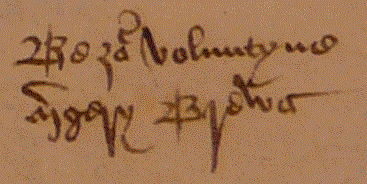There are two Valentines, both Italian, one a priest and the other a bishop, who were martyred and used to be commemorated in the Roman Catholic calendar on 14th February.
However, they have no romantic associations and the modern customs linked with St Valentine’s Day arise from a tradition according to which it is the day when the birds choose their mates for the year. This tradition was apparently inaugurated by Geoffrey Chaucer (circa 1342-1400) in The Parliament of Fowls. In this poem, “the noble goddess Nature” declares to the assembled birds:
You well know how on Saint Valentine’s Day, by my statute and through my ordinance, you come to choose your mates, as I prick you with sweet pain, and then fly on your way.
original text:
Ye knowe wel how, Seynt Valentynes day,
By my statut and thorgh my governaunce,
Ye come for to cheese — and fle youre wey —
Youre makes, as I prike yow with plesaunce.
According to Henry Ansgar Kelly, the director of UCLA’s Center for Medieval and Renaissance Studies, Chaucer most probably referred to 3rd May, the feast day of one St Valentine of Genoa – February being an unlikely time for birds to be mating in England. But 14th February has been the most popular St Valentine’s Day since the 15th century at least. There is evidence of this in Chronicles of London, a text written around 1450 which reports that in February 1421 Henry V came back from France with his new wife, Catherine de Valois, who was to be crowned queen in Westminster Abbey:
The xiiij day of Feuerell, that is to say vpon seynt Valentyne’s day, the Kyng com to London; and the xxiiij day of the same monyth sche whas crouned in Westmynster.
The link between St Valentine’s Day and the birds’ mating rituals was used by the English poet and playwright William Shakespeare (1564-1616) in A Midsommer nights dreame (circa 1595):
(Quarto 1, 1600)
Good morrow, friends. Saint Valentine is past:
Begin these wood birds but to couple now? (= Are these wood-birds only beginning to pair off now?)
In the 15th century, this link gave rise to a custom on St Valentine’s Day of choosing or drawing by lot a person of the opposite sex, called valentine, as a sweetheart, lover or special friend for the ensuing year. The word is first recorded in this sense in several letters written in 1477 by Margery Brews to her future husband John Paston. For example, one of these letters thus begins:
Unto my right well-beloved valentine John Paston, squire, be this bill delivered, &c.
Right reverent and worshipful and my right well-beloved valentine, I recommend myself unto you wholeheartedly, desiring to hear of your welfare.
original text:
Vn-to my ryght welbelouyd Voluntyn John Paston, squyer, be þis bill delyuered, &c.
Ryght reuerent and wurschypfull and my ryght welebeloued Voluntyne, I recommande me vn-to yowe full hertely, desyring to here of yowr welefare.
Margery Brews signed one of these letters:
Be your Voluntyne
Mergery Brews.

(source: British Library)
A valentine was also a paper with a person’s name on it, to be drawn by lot. To draw valentines was described by the antiquary Henry Bourne (1696-1733) in Antiquitates vulgares: or, the antiquities of the common people (1725):
It is a Ceremony, never omitted among the Vulgar, to draw Lots, which they Term Valentines, on the Eve before Valentine-day. The Names of a select Number of one Sex, are by an equal Number of the other put into some Vessel; and after that, every one draws a Name, which for the present is called their Valentine, and is also look’d upon as a good Omen of their being Man and Wife afterwards.
Other valentine customs involved gifts. Gloves were a popular love token. The Scottish songwriter Lady Grisell Baillie (1665-1746) recorded in her account books, on 23d February 1695, the following payment of one pound and ten shillings:
To Lisi Rainald for my Robin’s vallantin gloves.
In A Glossary; or, Collection of Words, Phrases, Names, and Allusions to Customs, Proverbs, &c. which have been thought to require Illustration (1822), the English clergyman and philologist Robert Nares (1753-1829) wrote that similar customs existed in France and that they were not related to any saint’s feast day:
According to the old customs of France, the Valantin [sic] was a moveable feast, namely the first Sunday in Lent, called also “Dominica de Brandonibus,” because […] boys used to carry about lighted torches (or brandons) on that day.
[Follows a French text according to which Valentine and Valentin were the names given to a girl and to a boy who, on that day, got engaged to be married. But if, by the fourth Sunday in Lent, she had not received any gift from him, she would break off her engagement by burning him in the effigy of a wisp of straw or of a vine shoot. Nares concludes:]
Here, then, we have the male and female Valantin and Valantine [sic], without any reference to the saint; and this seems better to account for our customs of that day.
When Nares was writing, the modern observances were becoming widespread. He remarked:
It is a curious fact, that the number of letters sent on Valentine’s Day, makes several additional sorters necessary at the Post Office in London.
